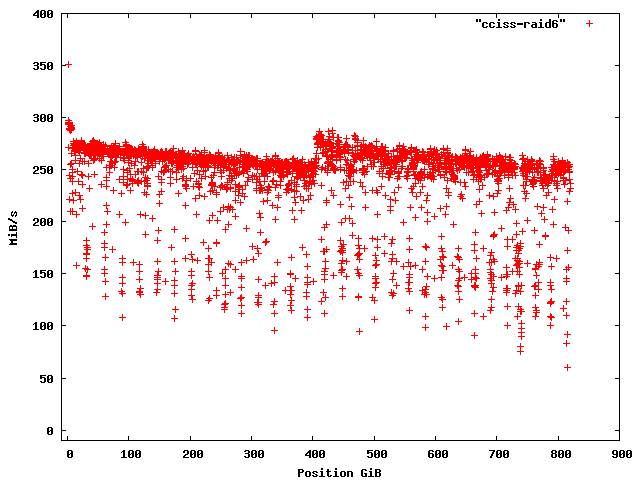I’ve just started work on a new HP server running RHEL5 AS (needs to be AS to support more than 4 DomU’s). While I still have the Xen issues that made me give up using it on Debian [1] (the killer one being that an AMD64 Xen Dom0 would kernel panic on any serious disk IO) but the Xen implementation in RHEL is quite solid.
The first thing I did was run zcav (part of my Bonnie++ benchmark suite) [2] to see how the array performs (as well as ensuring that the entire array actually appears to work). The result is below. For a single disk performance is expected to decrease as you read along the disk (from outer to inner tracks). I don’t know why the performance decreases until the half-way point and then starts with good performance again and again decreases.

The next thing was to ensure that the machine had RAID-6 (I have been convinced that that using only RAID-5 verges on professional malpractice). As the machine is rented from a hosting company there was no guarantee that they would follow my clear written instructions involving running RAID-6.
The machine is a HP rack-mounted server with a CCISS RAID controller, so to manage the array the command /usr/sbin/hpacucli is used.
The command hpacucli controller all show reveals that there is a “Smart Array P400 in Slot 1“.
The command hpacucli controller slot=1 show gives the following (amongst a lot of other output):
RAID 6 (ADG) Status: Enabled
Cache Board Present: True
Cache Status: OK
Accelerator Ratio: 25% Read / 75% Write
Drive Write Cache: Disabled
Total Cache Size: 512 MB
Battery Pack Count: 1
Battery Status: OK
SATA NCQ Supported: True
So the write-back cache is enabled, 384M of data is for the write-back cache and 128M is for the read cache (hopefully all for read-ahead – the OS should do all the real caching for reads).
The command hpacucli controller slot=1 array all show reveals that there is one array: “array A (SAS, Unused Space: 0 MB)“.
The command hpacucli controller slot=1 array a show status tells me that the status is “array AOK“.
Finally the command hpacucli controller slot=1 show config gives me the data that I really want at this time and says:
Smart Array P400 in Slot 1 (sn: *****)
array A (SAS, Unused Space: 0 MB)
logicaldrive 1 (820.2 GB, RAID 6 (ADG), OK)
Then it gives all the data on the disks. It would be nice if there was a command to just dump all that. I would like to be able to show the configuration of all controllers with a single command.
Also it would be nice if the fact that hpacucli is the tool to use for managing CCISS RAID arrays when using Linux on HP servers was more widely documented. It took me an unreasonable amount of effort to discover what tool to use for CCISS RAID management.

What’s the commandline you used to get the gnuplot data?
“I don’t know why the performance decreases until the half-way point and then starts with good performance again and again decreases.”
Two surfaces? All the way across the first (gradually decreasing) and then on to the second.
Don’t forget hpasm, hprsm and hponcfg for more poking at your hp hardware :)
http://www.coker.com.au/bonnie++/zcav/raid/
fromport: The above URL has all the source files, including the gnuplot command file.
Mark: That sounds like a reasonable theory, however I’ve never seen results from a disk like that. On one occasions someone sent me the output of a disk with multiple platters that did something like that, but that was the only one I ever saw. I’m still wondering whether it’s something funky with the RAID controller.
The divergence in the results was also greater than expected, it was unfortunate that I didn’t have time to do multiple test runs.
Dennis: Thanks, I’ll play with those later.
Try this:
hpacucli ctrl all show config detail
This should get you a long report for all installed cciss controllers, their Accelerator status, the configured Arrays and member disks.
Forgot to mention: hpasm does integrate with snmpd so you can use nagios or any other snmp-capable tool to monitor the health of your hp machine, including the raid array. If you have questions about it, just send me a mail :)
After reading your post I decided to take a look. After a couple of hours I bumped into this page:
http://h20293.www2.hp.com/portal/swdepot/displayProductInfo.do?productNumber=T8570AAE
You can download premade debs for debian etch! :)